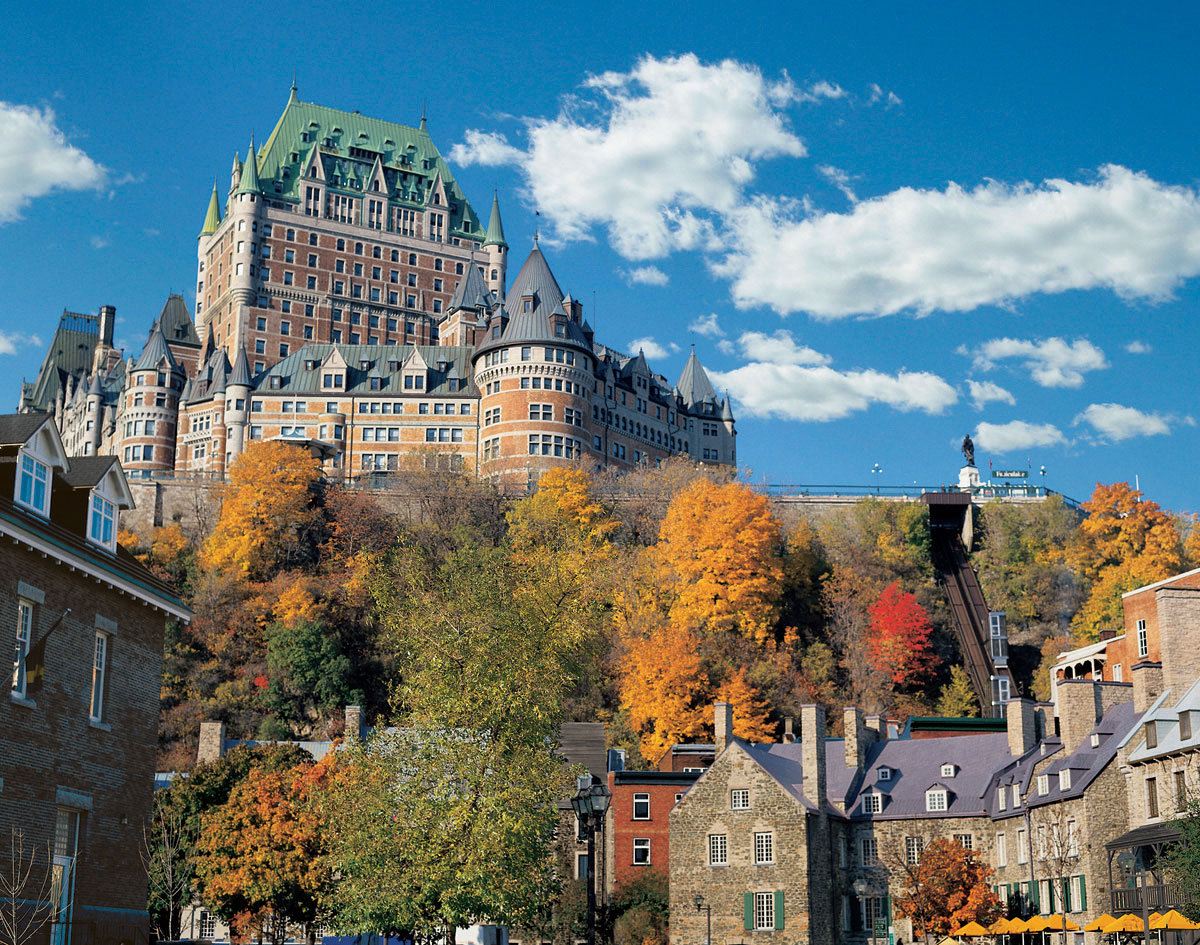Photo by Luc-Antoine Couturier
Canada’s Québec City offers visitors a bit of Old World Europe right here in North America.
Bienvenue. Welcome to Québec City and the Île d’Orléans. Join me as I share a recent visit to Canada’s historic French city. The language is an old, provincial style of French known as Québécois. Don’t be concerned if your French is non-existent. My ability to read French is somewhat passable, but speaking it, not so much. However, I learned that merci (thank you) and s’il vous plaît (please) worked for most situations.
Your reward can be flakey croissants in Le Château Frontenac’s Café de Terrace and exploring the European style cafés and shops of Old Québec’s “upper town” within a walled area atop Cape Diamond (Cap-Diamant).
It is also feeling transported back in time as you wander 17th and 18th century cobblestone streets around the jutting stone buildings of Old Québec’s “lower town” at the base of Cape Diamond next to the St. Lawrence River.
The journey continues with finding the gem that is Île d’Orléans, an island of charming churches, delicious cheeses, apple ciders, and homemade maple and chocolate candies.
Getting here
Navigate the St. Lawrence River from Lake Ontario to Québec City. Or boat up the river from the Gulf of St. Lawrence as Frenchman Jacques Cartier did in the 1550s. You will be docking in Bassin Louise’s Marine Port Québec, protected from tides by a lock. Berth reservations are required (see sidebar).
If you boat in, you will see the origins of the city’s name. The St. Lawrence River narrows at Cape Diamond, the city’s promontory. The Algonquin tribe called the settlement Kébec, which means “where the river narrows.” I would’ve loved to make my approach by water, but that wasn’t an option when people I met in Chicago invited me to explore their city this past summer. United Airlines had a two-hour direct flight from Chicago’s O’Hare Airport that made flying too easy. Driving here is also delightful, particularly in the fall, as I did years ago from New England to Montreal then to Québec.
You have an advantage arriving by boat. As you approach Cape Diamond, you see what looks like a castle in a walled city. It is historic Le Château Frontenac, the imposing hotel built by the Canadian Pacific Railway in the late 1800s that is now part of the Fairmont chain. The view, gazing up from the water, ignites photo snapping even before hopping onto the pier.
If you don’t arrive by water, you can of course tour the city that way. Vieux Port Yachting in the marina offers sailing tours on the St. Lawrence River.

Photo Courtesy of Le ChÂteau Frontenac
Festivals & Events

- For history lovers, check out Les Fêtes de la Nouvelle-France SAQ (New France Festival) August 7-13. The festival celebrates its 17th and 18th century roots with parades, street performers, concerts, food and re-enactments. Visitors can watch several events for free, but for access to some events and entertainment in lower town the Festival Medallion is needed. 866-391-FETE (3383); nouvellefrance.qc.ca
- If marching bands stir the soul, visit the city during Festival international de Musiques militaires de Québec (Québec City International Festival of Military Bands) August 20-25. Military bands from Canada and other countries parade and do free concerts at historical sites. 418-694-5757; fimmq.com
- Soulful folks won’t want to miss the International des musiques sacrées de Québec (Québec International of Sacred Music) September 7-15. The event features music played and sung by artists from Canada and around the globe. 418-525-9777; imsq.ca
- Carrefour International de theatre de Québec takes place May 21-June 8. 418-692-3131; carrefourtheater.qc.ca
- Image Mill tentative dates are scheduled June 15-September 15. 418-641-6290; lacaserne.net
- Québec Celtic Festival goes from the end of August through mid-September. 418-694-9147; morrin.org
- Several other festivals such as the Québec Opera Festival and the Bordeaux Wine Festival in Québec City have not yet announced their 2013 dates. Visit quebecregion.com later in the year and click on the “Events” tab.
Photo by Yves Tessier
Photo by Xavier Dachez
A city of festivals
My invite was during the SAQ New France Festival (Les Fêtes de la Nouvelle-France) held in Old Québec (Vieux-Québec). The SAQ in front of the festival name stands for Société des alcools du Québec, the Province of Québec’s liquor control board and an event sponsor.
I’m told the New France Festival began in 1997 in anticipation of the 400th anniversary of Samuel de Champlain’s fortifying the area for fur trade in 1608. But the festival’s official anniversary celebration was in 2008. Word is that it was so much fun the festival became an annual event. Think five days of parades, costumes and food.
People in period costumes are not just in the parades, they are everywhere. You bump into someone in a waistcoat or bonnet around every corner.
I kept tripping on the long skirt of a gown loaned to me by friends, but didn’t mind posing for tourists with cameras (even though I was also a tourist). If you come during this festival, don’t worry about renting a costume. Just bring your camera or cell phone to snap dozens of parade and party pictures.
“Old Québec is the perfect backdrop for an event that celebrates history,” says New France Festival director Stephan Parent. “But there is more to it,” he adds. “You can sip a drink, grab some local food at a cheap price, [and] chat with the crafters, the artists or some of the many impersonators who all have a story to tell. You might even learn a few French words!”
No problem if the New France festival doesn’t fit your plans. There’s bound to be something special going on when you arrive. The city loves festivals. Indeed, during boating season, which in the Québec City area is from mid-May to the end of September, there are more than 20 events ranging from art, music, theater and sports to ethnic food and wine (see sidebar).
Genevieve Parent, spokesperson for Le Château Frontenac, the city’s famed hotel, recommended coming during the Québec City Summer Festival (Festival d’été de Québec). Held July 4-14, the festival features more than 1,000 performers and 300 shows. “It’s a fun time, since there is music all around the city,” she says.
Photo op emersion
Festivals don’t have to determine your timing. Old Québec, a UNESCO World Heritage site, and nearby areas such as the Montmorency Falls and its park (Parc de la Chute-Montmorency) and Île d’Orléans are a photographer’s dream, amateur or professional. All you need are comfortable walking shoes and your favorite camera.
The ramparts of Old Québec and the Frontenac are your scenic background and become your daily playground. From Bassin Louise you can walk to Old Québec’s quaint inns, museums, cafés, churches, historic sites and boutiques in the upper and lower town.
Nestled in the Old Port district of Old Québec’s lower town, the marina is just steps from the antique stores of the Rue St. Paul. Before heading out, pick up a city map at the marina and go exploring. I took Rue St. Paul to Rue St. Pierre and found the Museum of Civilization (Musée de la Civilisation) at Rue Dalhousie. The exhibits are beautifully done so you leave with a good understanding of Canada and Québec.
From there I wandered the art galleries and interesting boutiques of the Petit Champlain Quarter, among the oldest still-existing commercial districts in Canada and the U.S. Indeed, the stairs in the district are Québec City’s oldest, dating to 1635. Once called the Champlain Stairs, they are known now as the Breakneck Steps because they are steep (but manageable).
You can try the different stairways between upper and lower town or take the Funiculaire, an enclosed, ski-style lift. I did both: The steps for exercise (and because they were free) and the Funiculaire because I liked the view and it was fun (though there was a fee to ride).
The Breakneck Steps and Funiculaire are conveniently located at Dufferin Terrace in upper town next to the Frontenac and end in the Petit Champlain district in lower town.
A short distance from the Dufferin Terrace and the stairs is the not-to-be-missed Notre Dame Basilica Cathedral of Québec (Basilique-Cathédrale Notre-Dame de Québec) on the City Hall’s square (Place de l’Hôtel de Ville). Closer to the Frontenac is the Holy Trinity Cathedral. An Anglican church, it’s copied after Saint-Martin-in-the-Fields in London. A seat in a royal balcony box is reserved for the UK’s reigning sovereign.
Room or bunk with a view
Dufferin Terrace was convenient because when I fell into bed after a day of walking and exploring, it was at the Frontenac. Queen Elizabeth stayed here, as did Alfred Hitchcock. U.S. President Franklin D. Roosevelt, Canadian Prime Minister William King and British Prime Minister Winston Churchill all met at the hotel in 1944 during World War II’s Québec Conferences.
I expected stuffiness and attitude. I was wrong. Everyone was pleasant, welcoming and happy to answer walking, touring, dining and internet connection questions — in perfect English.
If staying aboard your boat, special promotions in 2013 when the hotel undergoes a major renovation should put the Frontenac into the doable range, even if for just one night. Genevieve Parent thinks it adds to the Québec City experience. “You will live in a historic place that is the symbol of Québec City,” she says.
My problem with the Frontenac stay was trying to limit my pastry intake to just a few at the hotel’s buffet breakfast in Le Café de la Terrasse. Of course there were also healthy options of eggs, fruit, granola, smoked salmon and more. But I treasured Le Café’s flakey pastries that really are done right, and its view of the Dufferin Terrace Boardwalk.
From my room I could watch boats sail the river during the day. If bunking on your boat, you have a nightly show from mid-June to mid-September. Québec City’s history gallops, marches and flows during Moulin à Images (Image Mill), a creative graphic display projected across the 600 meter-long Bunge grain silos on the shore opposite the marina.

Photo by SÉbastien Laros
Eat out or stock the galley
Finding a good place to eat or pick up food to take back to the boat is not a problem in Québec City. The challenge is making a decision. The Frontenac’s café is always a fine choice; however, I didn’t find any place that I didn’t like.
Take a taxi out of Old Québec to the Grande Allée, a street lined with fun, upscale bistros including Savini Resto-Bar/ Vinotheque. Or walk to café-lined Rue Saint-Jean or the Saint Roch District of trendy restaurants and boutiques. I loved Table Bar Gastronomique for its nouvelle, international menu. It is in the Hôtel in Saint Roch.
To stock the galley with fruit, cheese and other fresh delectables, check out Old Port Market in Marche Vieux Port at the north end of Bassin Louise.
Island gem
I knew revisiting Old Québec would be a fun step into a café and gabled-roof, old-world atmosphere. What I didn’t know was that I would find a charming, quiet European countryside 15 minutes away from the city.
First timers to Québec will probably want to tour the Citadel (Citadelle). Begun in the 1600s and added to in the 1700s by the French, then changed into a star-shaped fortification by the British, the Citadelle is an active military garrison atop Cap Diamant, where it could protect the city from invasion. For an idea of the city’s military measures and great views of the town and river, walk the walls of the city’s fortifications just under 3 miles.
Having done both on a previous trip, I liked my friends’ suggestion of going over to the Île d’Orléans, an agricultural-based island of strawberries, apples, cheese and auberges that range from inns to restaurants, wineries, and a popular chocolate shop that is on the St. Lawrence River just 3 miles from Québec City.
What a jewel. Farms, orchards and vineyards spread across Île d’Orléans’ 73 square miles.
Six villages, five dating to the 1600s, dot Route 368, the main road that circles the island as Chemin Royal. Two country roads cut across, approximately dividing the island in thirds. Another road connects the bridge to Sainte Pétronille at the island’s western tip.
By land, it is reached across the Île d’Orléans Bridge from Beauport near Montmorency Falls, another must-see destination when visiting Québec. Bus tours go from Old Québec to the falls and the island.
If you boated to Québec, you can dock at the island’s marina at Saint-Laurent. Among six villages on the island, Saint-Laurent is on the south side facing the shoreline opposite Québec City. Island of Orleans Tourism is helpful when trying to connect with an island tour or taxi that can meet you near the marina. Another option is to bring bicycles. Bicycling is a great way to stop where and when you want.
While in Saint-Laurent, visit the Maritime Park to chat with guides about ship building and the area’s maritime history.
Churches and culinary treats
Because we tried to divide time between Montmorency Falls and the Île d’Orléans, my friends and I didn’t have nearly enough time to see the Maritime Park or explore every one of the island’s charming villages, churches, art galleries, wineries, microbreweries, bakeries, maple sugar shacks and shops. But we loved everywhere we did stop.
After tasting award-winning apple cider at Cidrerie Verger Bilodeau, we couldn’t leave without buying apple butter and maple candy for later. We didn’t know we would be munching our way around the island.
Bilodeeau is in Saint-Pierre. Founded in 1679 near the bridge, its Eglise Saint-Pierre is the oldest church on the island and usually displays works by local artists.
On the way to the next town, Sainte-Famille, we passed strawberry farms but we were past the season, so our next stop was Les Fromages de l’Île-d’Orléans. The shop was carrying on a tradition of cheese-making on the island that dated as far back as 1635. Costumed staff waited on us. The town, founded in 1661, is the oldest on the island.
Instead of continuing on to Saint-François, founded in 1679, we cut across the island on Route du Mitan to Saint-Jean, founded the same year. Its 1732 church and cemetery are popular tourist stopping points. So is La Boulange for bread or a snack.
Our next village was Saint-Laurent, which also cites 1679 as its founding. Along with being a port and former shipbuilding town, Saint-Laurent is home to art galleries and such crafts as ironwork and furniture. If time allows, check out Galerie d’art La Marée Montante, which represents about 30 renowned Canadian artists.
We were all set to leave the island when someone in our party remembered the Chocolaterie de l’Ile d’Orleans in Sainte-Pétronille. The Hurons are said to have lived there in the 1600s, but following growth as a resort destination, the area became a village about 1870.
Instead of returning to the bridge on the Rue de Prevost shortcut, we continued around. It was hard to say no to handcrafted Belgium chocolate. Only some of the chocolate made it home because we happily sampled what each other bought on a terrace overlooking the river.
My problem with this trip was twofold: Not fitting in even more than I did, but also not spending more time where I did stop because Old Québec and Ile d’Orleans were simply amazing.
“Québec generates an ambiance, a ‘joie de vivre’ that really immerses the visitor and makes his or her experience very lively,” says Parent.
Québec City Marinas
If boating to Québec, you will need to reserve a berth at the Old Port Marina in Bassin Louise. The marina is particularly busy from mid-June to mid-August.
Call 418-648-2233 or visit marinaportquebec.ca to make a reservation.
The marina has a swimming pool, modern facilities, restaurant and helpful staff. Its Vieux Port Yachting does sailing tours around Québec, which sometimes go past the Montmorency Falls and Isle d’Orleans.
For more information, call 418-692-0017 or visit vpy.ca.


